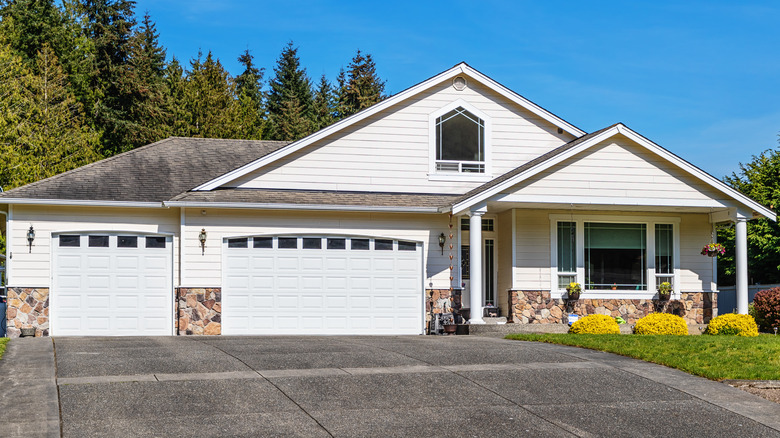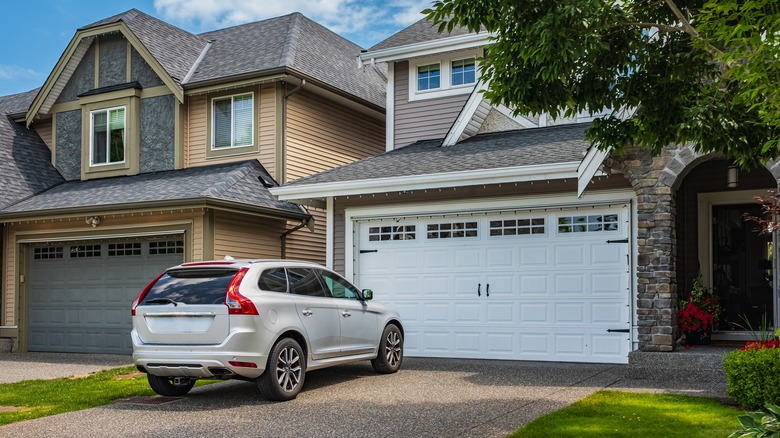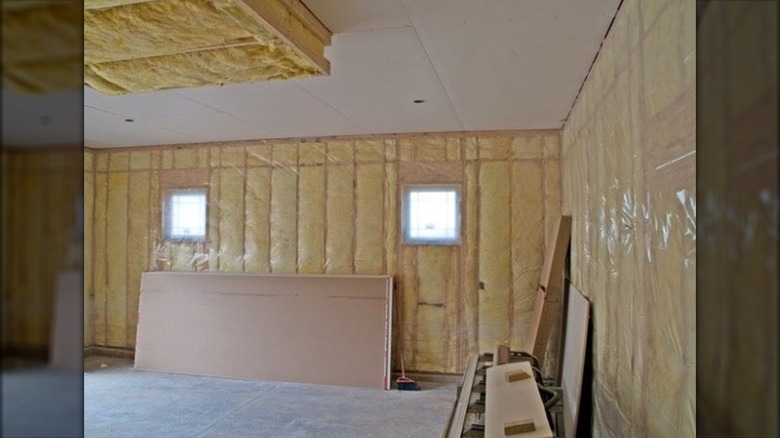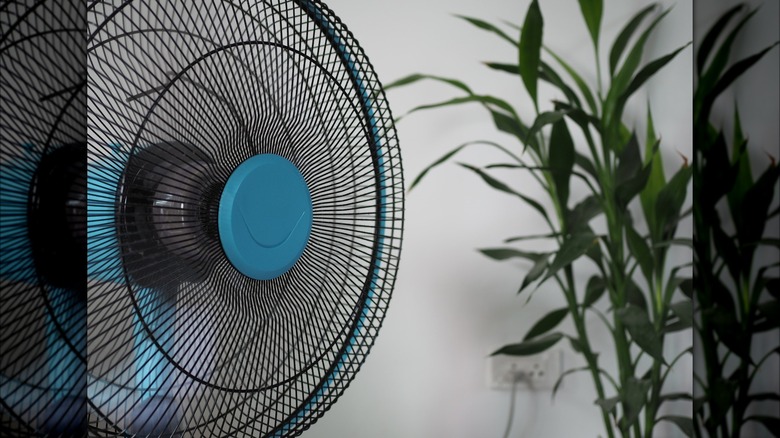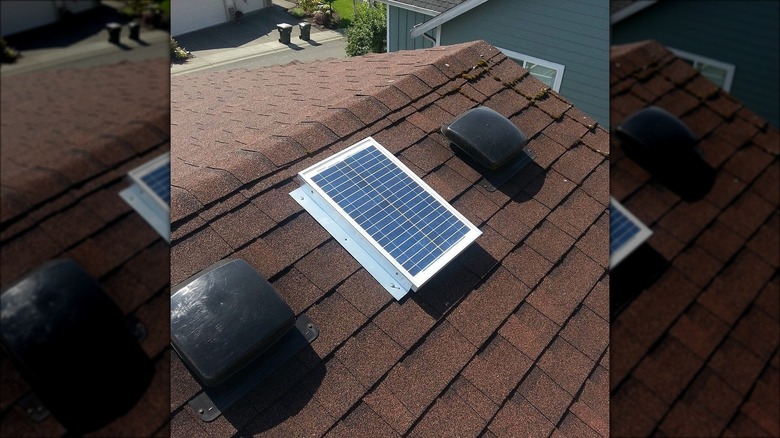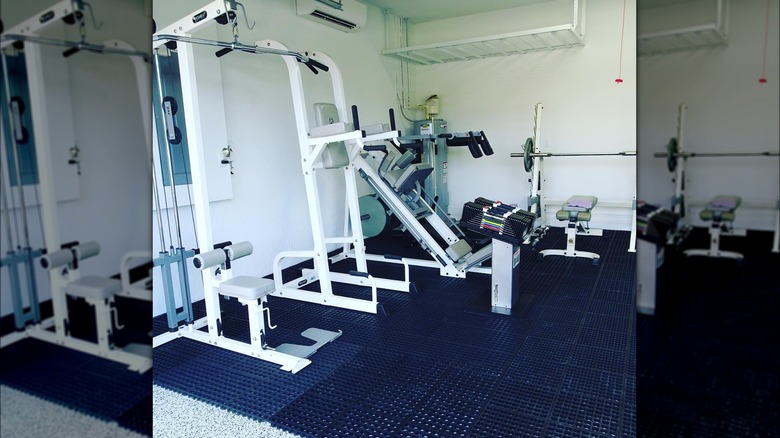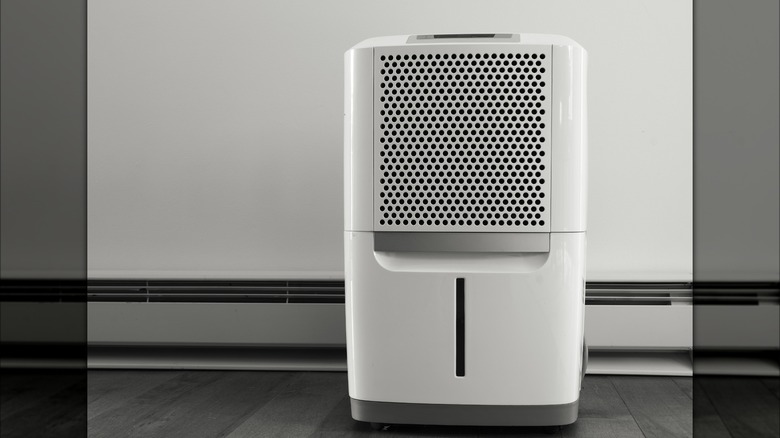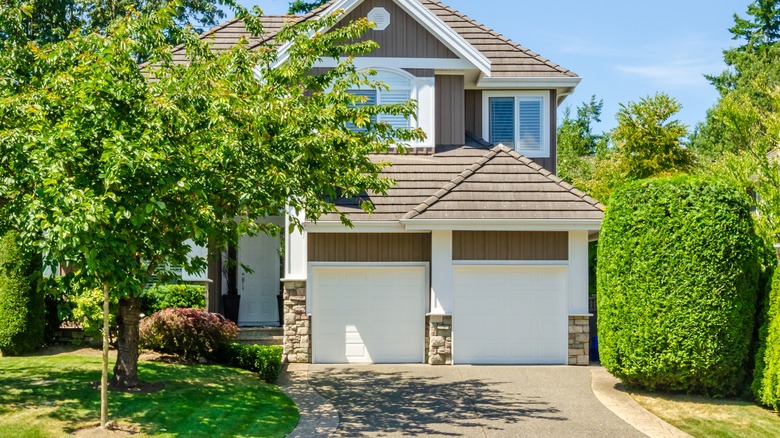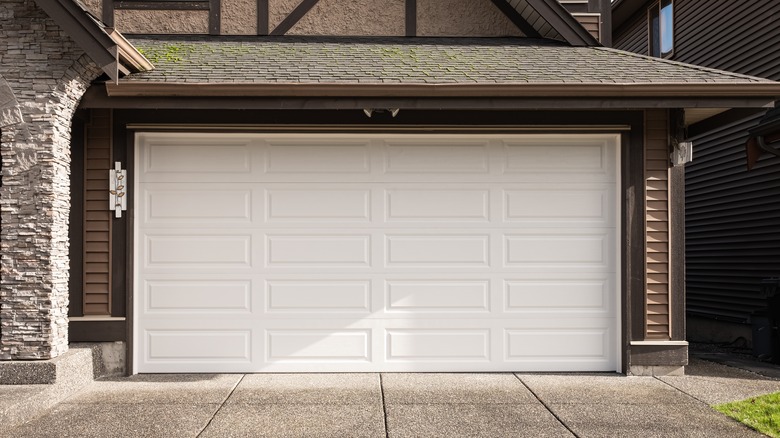The 10 Best Ways To Cool Down Your Garage During Toasty Summers
While a garage's primary role is to protect parked cars, the ancillary space doubles as a workshop, home gym, hangout spot, entertainment nook, tool shed, and storage room. As such, you'd want the space to be comfortable year-round. This means learning how to warm up your garage during freezing cold winters to beat the shiver-inducing chills. Similarly, you want to find the best ways to cool it during toasty summers to avoid resembling a rapidly melting ice cream cone. However, you must pinpoint the exact reason why your garage turns into a sauna when temperatures soar to take the right corrective action.
To elaborate, check if your garage is west- or south-facing because this would put it in the sun's line of attack, heating it up to uncomfortable levels. If you're good on that front, determine the parking space's insulation and ventilation. A lack of (or shoddy) insulation will allow hot air in and move cool air out. On the other hand, poor ventilation will stifle airflow and make you feel boxed in. Alternatively, a dark paint will greedily absorb heat. Same goes for a space stuffed to the brim. Thankfully, there are several ways you can beat the heat to continue enjoying your garage in the summer. But before you grab a chilled drink and settle in, ensure there are no holes or air leaks around the openings since they're energy inefficient and would ruin all your efforts.
Don't park your hot car inside immediately after use
Parking your car in its designated spot after use might be a force of habit for you, but it could contribute to a hotter garage. To put this into perspective, a car engine's temperature generally fluctuates between 195 and 220 degrees Fahrenheit. Worse, overheating and unfavorable weather conditions might push the range further, turning the engine hotter. Naturally, the engine and exhaust give off heat during and after use as they cool down. This simple action will warm the inside of your garage, with the floors greedily absorbing the offending heat, especially concrete.
So, let your car cool down before moving it inside. The easiest way is to park your car near the house, turn off the engine, and come back after 30 to 45 minutes to check on the situation. If the engine is cool to the touch, park the automobile inside the garage. To speed up the cooling process, choose a shaded area to keep it out of the sun's burning glare. If it's still hot, give it some more time to cool down. However, if you don't have a lot of space on your street, lack a shaded area, or can't leave it outside, move the vehicle inside the garage, but refrain from closing the door immediately. Be patient and leave it open until the engine cools down.
Ensure your garage is well-insulated
Does the room attached to your garage wall seem scorching in the summer? Chances are you need to insulate (or re-insulate if it's been a few years) the parking space to keep it from retaining heat. Besides, a temperature-controlled garage will put less strain on your centralized system, lowering your electricity bills. It's crucial since the national average for the residential cost of electricity is up 77 cents from last year and has reached 16.68 cents per kilowatt-hour (via the US Energy Information Administration). Plus, an insulated garage will lead to noise reduction and protect the stored items and parked automobiles from heat damage.
However, not just any insulation will do. Choosing the right type of insulation for your garage is necessary to maintain a comfortable atmosphere inside throughout the year. To do that, consider your region's climatic conditions, R-value of the material (aka its ability to resist heat), and your budget. For instance, if you experience hot weather for the better part of the year, you want something that'll slow down heat absorption and keep the cool air in for longer. Similarly, the insulation material must be rated between R-30 and R-60. Finally, determine your budget since a garage insulation is an expensive project and Angi estimates it can cost between $1,900 and $7,700, depending on the area covered and the insulation type you go with. If full-blown insulation isn't in the cards, at least insulate the door to maintain a cool environment indoors.
Use a fan (or two) for efficient airflow
Garages usually don't see much airflow unless you crack the window or keep the door open while working on your passion project. This lack of air circulation often leads to the space feeling stuffy and hot in the summer months. Since merely leaving the doors open won't bring you relief, use a fan (or two) to improve the room's airflow. However, before you break out your pedestal fans and prepare yourself for a cool garage, know that this method won't actively lower the temperature inside. Instead, it'll cool your body by assisting the evaporation of sweat lingering on your exposed skin, but placement is key.
If you don't have a window, open the garage door and arm yourself with two pedestal fans. Adjust the height of the two fans such that one is close to the floor to move the sunken cool air around, with the other standing tall as a sentinel and pushing the risen warm air out. Now, position the 'short' fan facing inward on one end of the door and turn the 'tall' one outward on the opposite end. This strategic placement will help create a cross-breeze with the shorter fan inviting cooler air in and its tall colleague blowing hot air out. If you have a window, position the cool air-blowing fan in a shady spot and vice versa. Remember, this method won't be effective when the temperature crosses 100 degrees Fahrenheit.
Improve your garage's ventilation
If you need a more robust solution than fans to cool down your garage during toasty summers, ventilate it to move the stale air out and bring fresh air in. This won't just make the oppressive heat more manageable but also reduce energy consumption, giving your overworked and frazzled HVAC system some much-needed relief. Further, you won't have to worry about your stored electronic devices malfunctioning, food cans going bad, or your automobile's battery liquids vaporizing before your eyes. More importantly, a well-ventilated garage won't be at risk of developing mold and mildew.
So, investing in ventilation is the best way to protect your garage from mold growth. You can go with an active ventilation system or opt for its passive relative. While the former is powered by electricity, the latter relies on wind energy to get the job done. As such, an active ventilation system is more effective at eliminating the moisture build-up and hot air from your garage. Outfitted inside the garage (usually on the wall opposite the door), these systems tend to be more expensive and are relatively high-maintenance. Plus, it's recommended to get an expert to install them since they're dependent on electricity. On the other hand, passive systems are installed atop the garage roof and don't require much energy to ventilate the parking space. Although you save on unit, installation, and running costs, the results will be mediocre at best, especially if there's not much of a cool breeze.
Outfit your garage with an air conditioner
If budget isn't an issue and you (or your family members) spend a considerable amount of time in the garage, install an air conditioner (AC). Besides effectively cooling the space on hot days, there are multiple energy-saving benefits of installing an air conditioner in your garage. For starters, the heat from your garage won't permeate the connected rooms in your house, relieving your HVAC from working overtime to maintain a consistently cool indoor environment. However, insulate your garage first and don't tap into the central unit since it'll overload the system and allow automobile fumes and other toxins to infiltrate the air ducts.
There are mainly three kinds of ACs you can install in your garage. Window ACs are ideal for parking spaces with a window and a relatively modest square footage. Plus, they won't put too much strain on your budget and are simple to install. On the flip side, these units are loud and aren't an ideal fit for all types of windows. So, if these cons are a deal-breaker or you have a large space, consider installing a mini-split AC. They aren't noisy, are energy efficient, and come with an outer condenser and an inner unit, eradicating the need for ducts. However, they are costlier and require a pro for adequate installation. A portable unit can also be a good option, but it's worth keeping in mind that they won't be much help if the temperature hits 90 degrees Fahrenheit.
Run a dehumidifier in your garage
For homeowners residing in regions with high humidity, the atmosphere in your garage can feel downright oppressive. This is because humid air is saturated with water vapor and can't absorb more moisture. Simply put, humid air will prevent your sweat from vaporizing, effectively slowing down the body's cooling process and making you feel more uncomfortable. Plus, if you keep the door and window open, it'll invite warm air indoors. When the moisture-filled hot air collides with the cooler air inside your garage, it'll lead to unwanted condensation on the walls.
A damp environment will aid and abet the growth of mold and mildew. Exposure to the spore won't just lead to health complications but also make the space smell rank. Not to mention the damage they'll wreak on your automobiles and stored documents. The cherry on top will be the development of rust on your beloved cars' metal components, hindering their functionality and marring their look.
However, a dehumidifier will take care of the excess moisture by taking in the moisture from the atmosphere and regurgitating dry air. Regarding the type, a refrigerant (or compressor) unit is best suited for summer months. They employ a fan to trap the moisture in the air before passing it along chilly coils. The condensed water is moved to a tank and warm, dry air is recirculated back. Although the absence of humidity will make the garage feel cooler, the dehumidifier won't actively lower the temperature inside.
Plant trees nearby for some much-needed shade
Imagine how much cooler your garage would be if it didn't have to deal with the sun beating down on it directly. This is why you need to plant trees nearby. Trees cool the surrounding areas through two methods: shading and evapotranspiration. While the exact amount varies on canopy density and plant variety, usually only 10 to 30% of sunlight reaches the structures shaded by trees. Additionally, trees use the environment's heat for evapotranspiration, lowering the air temperature. While a tree is enough to provide some much-needed shade on hot days, a study states that a tiny urban forest can decrease the day temperatures in summer by 10 degrees Fahrenheit.
But you can't plant trees willy-nilly. Choosing the right variety is crucial. Examine the weather conditions, your USDA growing zone, soil quality, and the site's drainage ability. You also want to take note of the nearby structures, like pavements and driveways, below-ground utility lines, and aboveground power transmission lines. Regarding its location, you'll want to plant a tree in relation to your home's direction. For instance, if it's situated in the south or southeast, plant the tree cover in the southwest end to beat the brutal afternoon sun. Further, consider the tree's size and space requirements to finalize its distance from the garage. The variety, size, and shape will depend on your needs — deciduous trees offer shade in summer and sunlight in winter. Remember to check your HOA rules before planting trees.
Pick lighter tones for your garage door
According to the Cooling Your Home Naturally report issued by the U.S. Department of Energy (DOE), dark colored house exteriors tend to soak in 70 to 90% of solar radiation. So, it isn't a good idea to choose dark shades for your garage door, especially if you experience warm weather for the majority of the year, aka continuously contend with (except a few winter months) a temperature of 95 degrees Fahrenheit or higher. Simply put, you shouldn't paint your garage door black or any other dark tone since they're energy inefficient and will undercut your efforts to cool your garage.
Instead, go for light shades because they reflect most of the sun's UV rays and won't heat your garage. Bonus points if you pick a shade with reflective properties. To choose the right shade for your garage, decide if you want the door to be the focal point of your home's exterior or would rather it blends in with its surroundings. If you choose the first option, a complimentary tone will help attract eyeballs. Otherwise, selecting a shade similar to the exterior of the house will make the door blend while visually enhancing your home's square footage. The door's material will also influence your choice. For instance, you'll need latex paint for a steel door while aluminum will need an oil-based primer. Finally, follow the HOA rules and the neighborhood color aesthetic.
Keep the doors shut when the sun is shining outside
During summer, you may be tempted to keep the garage doors and windows open in hopes of a natural breeze. Sadly, this can prove disastrous when the humidity and temperature outside are higher, especially if the structure receives direct sunlight. The action will also serve as a "come-one, come-all" invitation for pests; the allure of escaping the sun and having potential access to food would be too much for them to resist. Moreover, dust and debris will settle inside and you'll have to clean your garage floors to keep them looking like new. Even though a screen door might deter pests and filter out dirt, intruders might have no qualms entering your sanctuary on silent feet, so keeping the doors closed is a vital step in protecting your garage from break-ins.
Consequently, it's necessary to keep the doors shut when the ball of fire is blazing outside. Try to minimize the number of trips in a day to reduce heat gain. Better yet, capitalize on the early morning and late evening hours if possible. If you're planning to spend a couple of hours inside your garage, aim to knock off your to-do list before 11 a.m. to avoid the brunt of the sunlight. Try leaving the door open for a while in the cool early morning hours before you settle in to dissipate the accumulated heat. Additionally, invest in blackout shades, curtains, or shutters for the windows to discourage heat conduction. However, if the structure is shaded, try opening the windows and doors for a few minutes to promote airflow.
Declutter the garage
You section off a tiny area to store a few items, and before you know it the garage has (unconsciously) assumed the role of your dumping ground. A garage that resembles a hoarder's den will look untidy, lead to unwarranted tripping accidents, and is also a fire hazard. Besides, the large boxes are adept at storing heat and will make you sweat more in the summer. Plus, they'll inhibit air flow and retain moisture, deteriorating your garage's breathability. Fortunately, decluttering is a simple garage cleaning tip you don't want to skip.
Start by critically analyzing the items you're storing. If you only have a few large items to deal with and maybe a few tiny boxes, don your cleaning gear, set your favorite playlist, and knock it off on a weekend. But if your garage veers dangerously into hoarder territory, divide it into sections and tackle them one by one to avoid getting overwhelmed. The sections could be as innocuous as baby clothes, paint supplies, car cleaning tools and products, summer pool toys, and Christmas decorations. Now, create piles for items you want to keep, sell, donate, or trash, as well as one for hazardous or electronic items, and sort all items into one of the five piles. For the items in the "keep" pile, organize them into coordinating weather-resistant bins or boxes before labeling them neatly. Add some shelves, a pegboard, wall-mounted rail systems, bike-appropriate hooks, or a slat wall system to organize the chaos.

